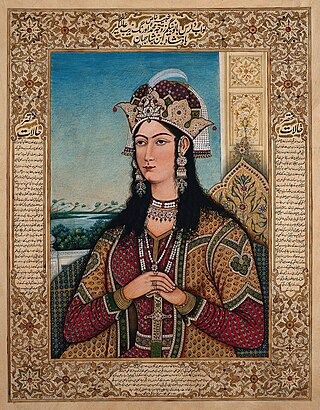
Qudsia Begum, born Udham Bai was a wife of Mughal emperor Muhammad Shah and mother of emperor Ahmad Shah Bahadur. She was early born an administrator and served as de facto regent from 1748 to 1754.

Mirza Abu'l Fayaz Qutb-ud-Din Mohammad Azam, commonly known as Azam Shah, was briefly the seventh Mughal emperor from 14 March to 20 June 1707. He was the third son of the sixth Mughal emperor Aurangzeb and his chief consort Dilras Banu Begum.

Mirza Nasir-ud-Din Muḥammad Shah was the thirteenth Mughal emperor from 1719 to 1748. He was son of Khujista Akhtar, the fourth son of Bahadur Shah I. After being chosen by the Sayyid Brothers of Barha, he ascended the throne at the young age of 16, under their strict supervision.

Mirza Aziz-ud-Din Muhammad, better known by his regnal name Alamgir II, was the fifteenth Mughal emperor from 1754 to 1759. He was the son of Jahandar Shah.

Ahmad Shah Bahadur, also known as Mirza Ahmad Shah or Mujahid-ud-Din Ahmad Shah Ghazi, was the fourteenth Mughal emperor, born to Emperor Muhammad Shah. He succeeded his father to the throne in 1748, at the age of 22. When Ahmed Shah Bahadur came to power, the Mughal Empire started to decline. Furthermore, his administrative weakness eventually led to the rise of the usurping Imad-ul-Mulk.

Shah Alam II, also known by his birth name Ali Gohar, or Ali Gauhar, was the seventeenth Mughal emperor and the son of Alamgir II. Shah Alam II became the emperor of a crumbling Mughal Empire. His power was so depleted during his reign that it led to a saying in the Persian language, Sultanat-e-Shah Alam, Az Dilli ta Palam, meaning, 'The empire of Shah Alam is from Delhi to Palam', Palam being a suburb of Delhi.

Mirza Azim-ush-Shan was the second son of Mughal emperor Shah Alam I, by his second wife, Amrita Bai, Princess of Kishangarh. He was the great grandson of Emperor Shah Jahan and the grandson of Emperor Aurangzeb, during whose reign he was the last subahdar (viceroy) of Bengal Subah, Bihar Subah and Orissa Subah from 1697 to his death in 1712.

Najib ad-Dawlah, also known as Najib Khan Yousafzai, was a Rohilla Yousafzai Afghan who earlier served as a Mughal serviceman but later deserted the cause of the Mughals and joined Ahmad Shah Abdali in 1757 in his attack on Delhi. He was also a House Chief of Rohilkhand, and in the 1740s founded the city of Najibabad in Bijnor district, India. He was instrumental in winning the Third Battle of Panipat.

Feroze Jung III or Nizam Shahabuddin Muhammad Feroz Khan Siddiqi Bayafandi also known by his sobriquet Imad-ul-Mulk, was the grand vizier of the Mughal Empire when it was under Maratha suzerainty, making them the de facto rulers.

Zabita Khan Rohilla was a Rohilla chieftain in the time of the Mughal Emperor Shah Alam II.

Mirza Mahmud Shah Bahadur, also known by his regnal name Shah Jahan IV, was the eighteenth Mughal emperor for a brief period in 1788 after Shah Alam II was deposed by Ghulam Kadir, Mahmud Shah Bahadur was the son of a former Mughal Emperor, Ahmad Shah Bahadur. He himself became emperor for a brief period in 1788 as a puppet of Ghulam Kadir, after Shah Alam II had been deposed and blinded. He was allegedly put to death in 1790 by order of Shah Alam II, supposedly for usurping his authority in 1788.

Dilras Banu Begum was the first wife and chief consort of Emperor Aurangzeb, the sixth Mughal emperor. She is also known by her posthumous title, Rabia-ud-Durrani. The Bibi Ka Maqbara in Aurangabad, which bears a striking resemblance to the Taj Mahal, was commissioned by her husband to act as her final resting place.

Jahanzeb Banu Begum, popularly known as Jani Begum, was a Mughal princess and the chief consort of Muhammad Azam Shah, the heir-apparent to Emperor Aurangzeb, who briefly became Mughal emperor in 1707.
Aurangabadi Mahal was a consort (concubine) of the Mughal emperor Aurangzeb.
Badshah Begum was from 8 December 1721 to 6 April 1748 as the first wife and chief consort of the Mughal emperor Muhammad Shah. She is popularly known by her title Malika-uz-Zamani which was conferred upon her by her husband, immediately after their marriage.
Shahar Banu Begum was Empress consort of the Mughal Empire from 14 March 1707 to 8 June 1707 as the third wife of Emperor Muhammad Azam Shah. She is popularly known by the titles Padishah Bibi and Padshah Begum.
Hazrat Begum, also known as Hazrat Mahal and Sahiba Begum, was a Mughal princess, as the daughter of Mughal Emperor Muhammad Shah. She was a wife of Ahmad Shah Durrani, the first emir of the Durrani Empire.
Iffat-un-Nissa Begum was a Mughal princess, the daughter of Prince Dawar Bakhsh, the great grandson of Emperor Shah Jahan.
Ghulam Kadir, fully Ghulam Abd al Qadir Ahmed Khan, was a leader of the Afghan Rohilla during the late 18th century in the time of the Mughal Empire. He is particularly known for blinding the Mughal Emperor Shah Alam II and occupying and plundering Delhi for two and a half months in 1788.
Mian Qutb Shah or Qutb Khan was an Indian Muslim Sardar and formerly a collector of Saharanpur, Uttar Pradesh. He was best known as the slayer of Dattaji Rao Scindia.













